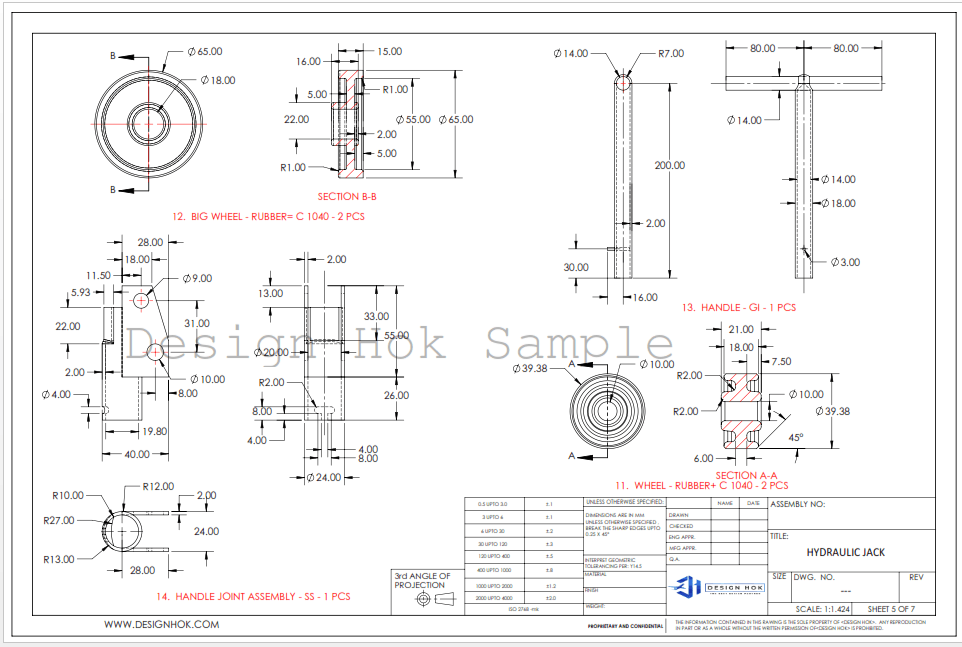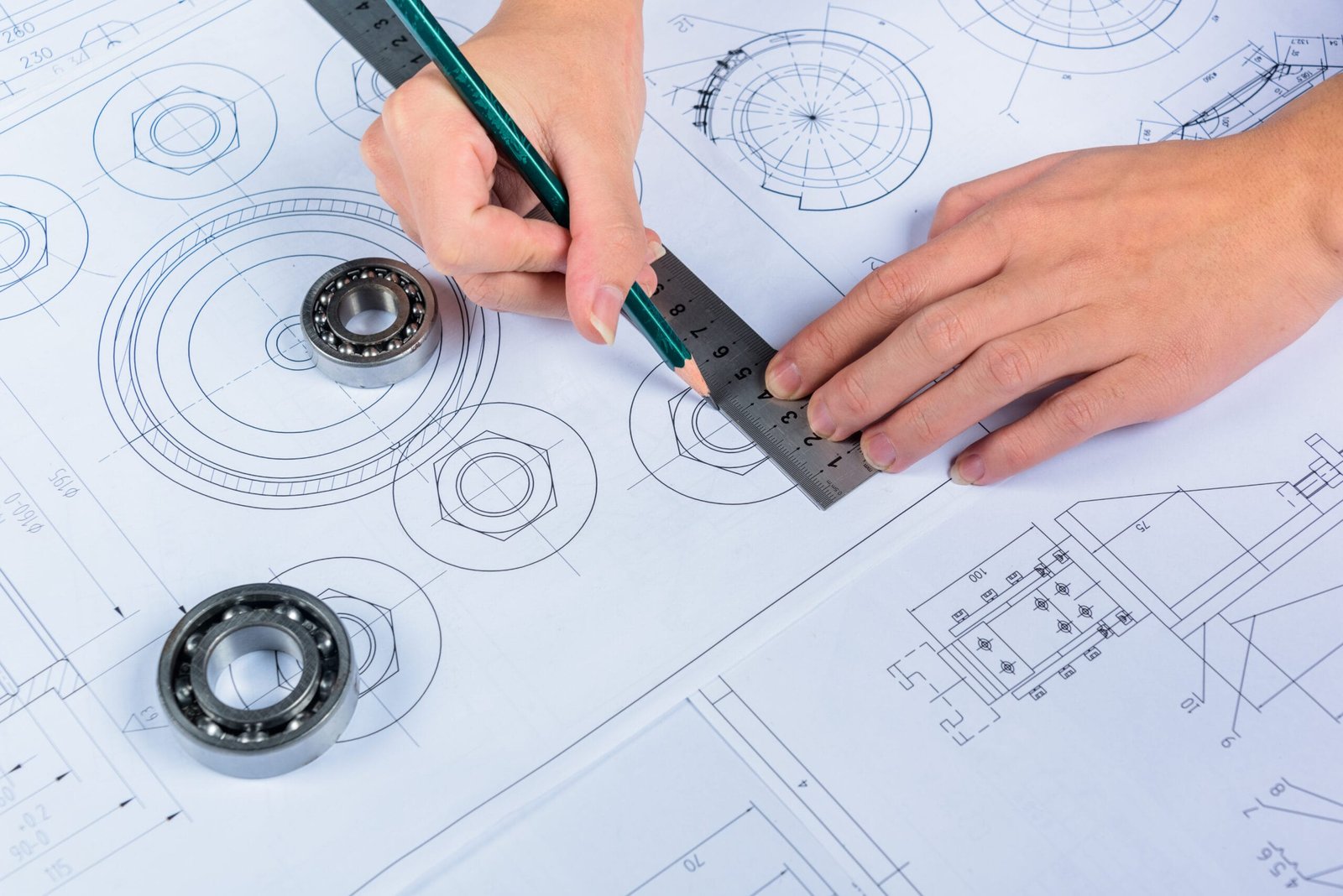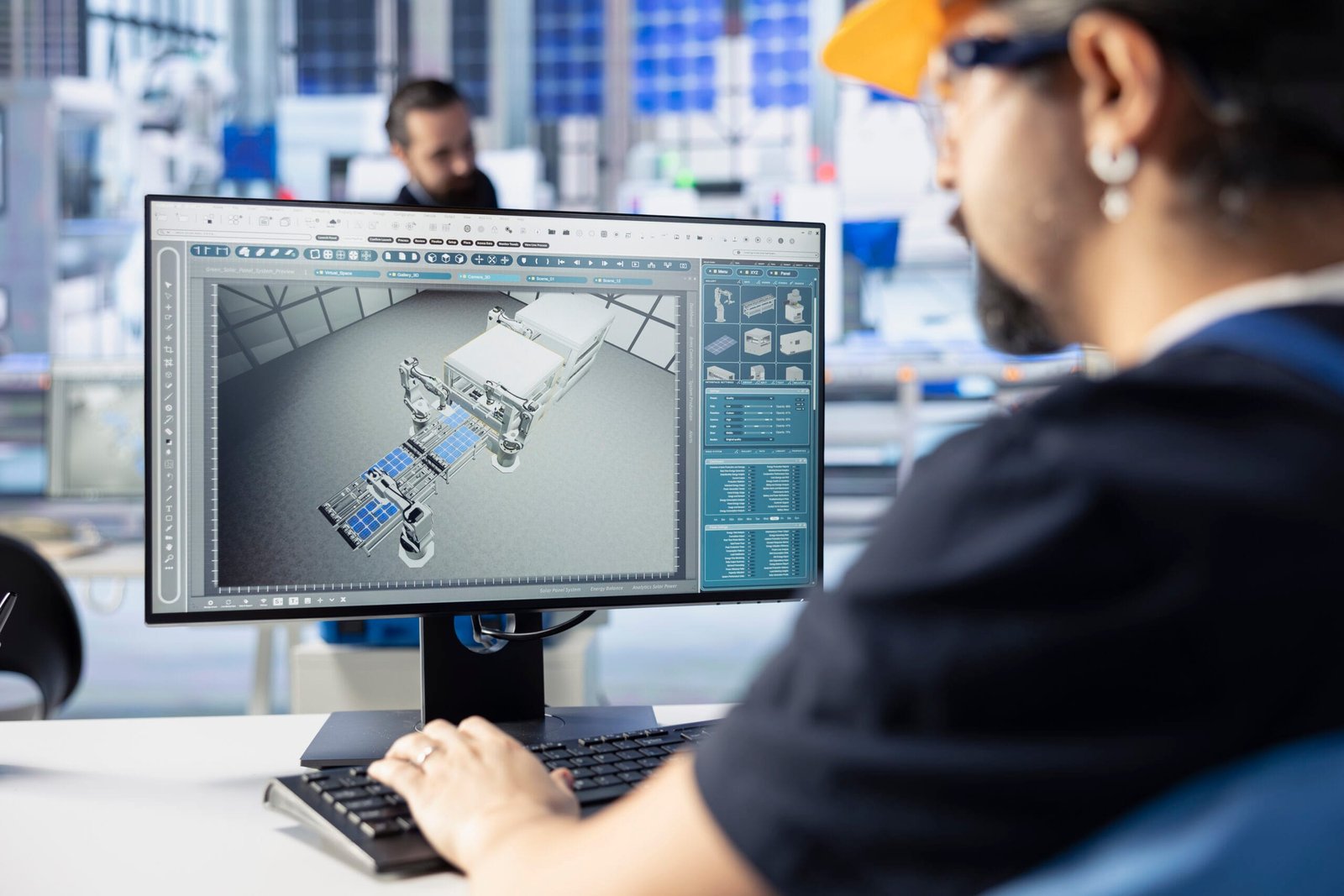Introduction: What is AS 9100 in CAD and 2D 3D Modeling?
AS 9100 in CAD and 2D 3D Modeling is a quality management standard designed for the aerospace, defense, and aviation industries. While many people think it applies only to factory floors and production processes, Also affects how AS 9100 in CAD and 2D 3D Modeling
Designs created in CAD software must meet the same strict quality and traceability standards as manufactured products. This article explains how AS 9100 impacts 2D drawings and 3D models, and how design teams can comply easily and efficiently.
Table of Contents
- What Is AS 9100?
- Why Is AS 9100 Important in CAD and Modeling?
- How CAD and Modeling Fit Into the AS 9100 QMS
- Key AS 9100 Clauses Related to Design
- AS 9100 and 2D Drafting
- AS 9100 and 3D Modeling
- Common Design Mistakes That Violate AS 9100
- How to Ensure AS 9100 Compliance in CAD Workflows
- Benefits of AS 9100 for Design Engineers
- Tools and Best Practices for AS 9100 Compliance
- How to Audit Design Teams Under AS 9100
- Real-World Example: Aerospace Component Design
- Final Thoughts
- Frequently Asked Questions (FAQ)
1.What Is AS 9100 in CAD and 2D 3D Modeling?
AS 9100 in CAD and 2D 3D Modeling is a global quality management standard built on ISO 9001 but made specifically for aerospace and defense industries. It adds extra rules about product safety, traceability, risk management, and supplier control.
In CAD and modeling, AS 9100 affects how:
Drawings are created
Models are updated and tracked
Versions are controlled
Data is shared with manufacturing teams
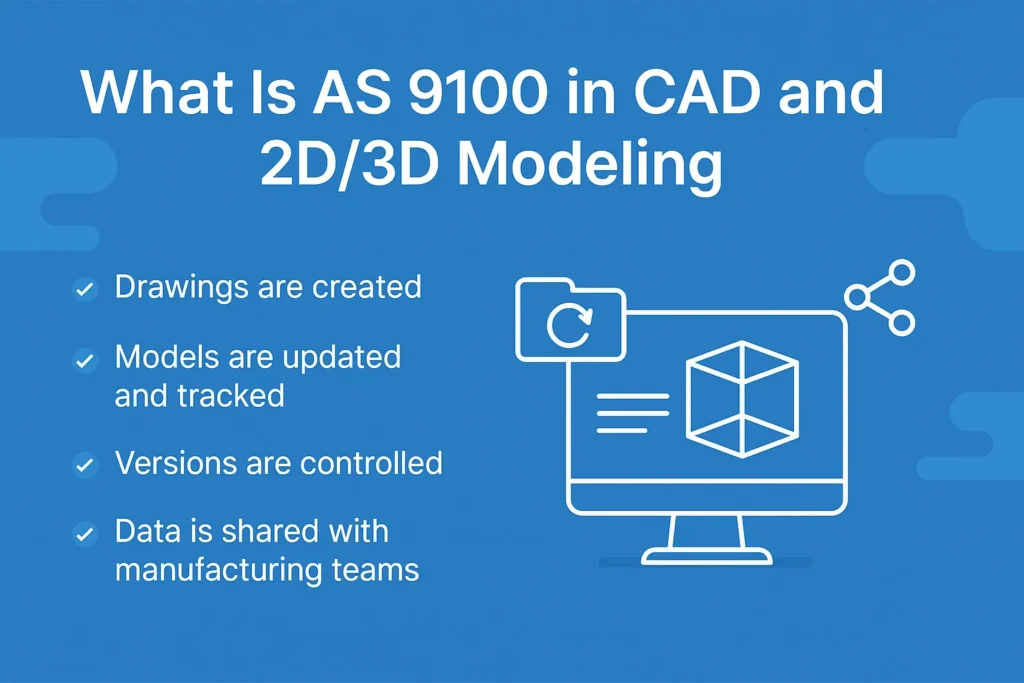
2. Why Is AS 9100 in CAD and 2D 3D Modeling?
In aerospace, a single design error in a 3D model or 2D drawing can cause major failures, safety issues, or cost overruns.
AS 9100 ensures:
- Accurate and up-to-date designs
- Proper version control of drawings
- Traceability from design to final product
- Collaboration between design and production teams
If you’re a CAD designer or design engineer working in aerospace or defense, your work must follow AS 9100 rules.
3. How CAD and Modeling Fit Into the AS 9100 QMS
AS 9100 requires companies to have a Quality Management System (QMS). CAD and 2D/3D modeling are part of this system because:
- Designs guide production and inspection
- Errors in design affect the whole lifecycle
- CAD models are part of product configuration
So, your design workflow must follow the company’s QMS policies, including documentation, control, and approval processes.
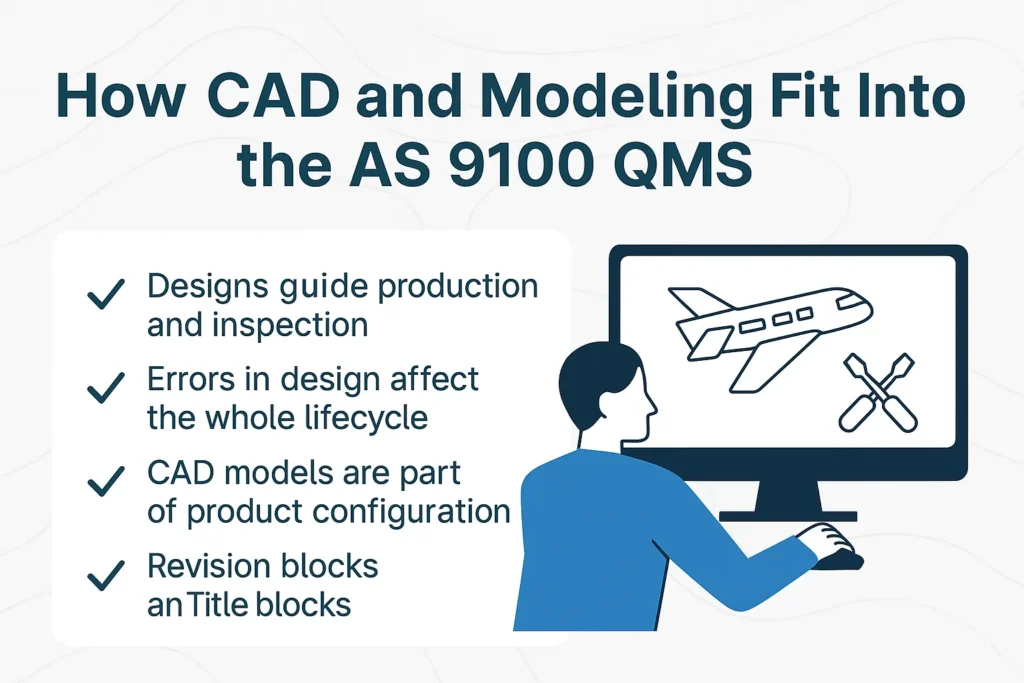
4. Key AS 9100 in CAD and 2D 3D Modeling Clauses Related to Design
Here are the most important AS 9100 clauses that relate to CAD and modeling:
Clause 8.3 – Design and Development
- Plan design stages
- Review and approve models
- Document design changes
Clause 7.5 – Documented Information
- Control of design files (CAD, PDF, STEP, etc.)
- Prevent unauthorized changes
- Keep history of all versions
Clause 8.5 – Production and Service Provision
- Ensure design data matches production
- Provide clear drawings and tolerances
These clauses require strict control over your 2D drawings and 3D models, including how they are created, stored, and changed.
5. AS 9100 and 2D Drafting
2D drawings are still widely used in aerospace for:
- Technical documentation
- Assembly instructions
- Inspection references
AS 9100 impacts 2D drafting by requiring:
- Clear dimensioning and tolerances
- Proper revision labels and approval stamps
- Linking drawings to part numbers and change history
Drawings must also show who created, reviewed, and approved them to ensure full traceability.
6. AS 9100 and 3D Modeling
3D models are often used as the “master” definition of a product. AS 9100 ensures that 3D modeling follows standards for:
- File version control
- Geometry validation
- Fit, form, and function checks
- Interface control
The models must match exactly what’s manufactured. If the model changes, the product changes—and that means updated reviews, approvals, and records.
7. Common Design Mistakes That Violate AS 9100
Many companies lose AS 9100 in CAD and 2D 3D Modeling certification due to design-related issues, such as:
- Missing revision control
- Using outdated models or drawings
- Failing to document design changes
- Not validating models before release
- Inconsistent dimensioning standards
By avoiding these mistakes and building quality into the design process, companies stay compliant and reduce risk.
8. How to Ensure AS 9100 in CAD and 2D 3D Modeling Compliance in CAD Workflows
a. Use Document Control Software
Use PLM (Product Lifecycle Management) or PDM (Product Data Management) tools like:
- SolidWorks PDM
- Siemens Teamcenter
- Autodesk Vault
These tools track changes, manage revisions, and prevent unapproved edits.
b. Standardize Your Drawing Templates
Make sure all drawings include:
- Revision blocks
- Title blocks with designer/reviewer
- Material specs and tolerances
c. Conduct Design Reviews
Before finalizing any model or drawing, hold formal reviews involving:
- Design engineers
- Manufacturing leads
- Quality control teams
d. Train Design Staff on AS 9100
Make sure your team knows:
- AS 9100 clauses that apply to design
- Company’s QMS process
- How to properly store and update CAD files
9. Benefits of AS 9100 in CAD and 2D 3D Modeling Engineers
When design teams follow AS 9100, they experience:
- Fewer errors and rework
- Improved communication with production
- Higher-quality designs
- Better career growth in aerospace industries
- Global job opportunities with certified companies
Following the standard also builds a culture of responsibility and attention to detail.
10. Tools and Best Practices for AS 9100 in CAD and 2D 3D Modeling Compliance
Here are tools that help with CAD and modeling under AS 9100:
| Tool Name | Purpose |
| SolidWorks PDM | Document control and revisioning |
| Autodesk Inventor | Parametric 3D modeling |
| Teamcenter | PLM platform with AS 9100 controls |
| FMEA Tools | Risk analysis during design |
| CheckMate for CAD | Design rule checking |
Best Practices:
- Always use the latest approved template
- Maintain naming conventions for files
- Log all design meetings and approvals
- Regularly audit your design folders
11. How to Audit Design Teams Under AS 9100
Design audits under AS 9100 check:
- Are the designs following customer and regulatory needs?
- Are the drawings/models controlled by revision?
- Are changes tracked with full history?
- Are design reviews documented?
- Are designers trained in the QMS?
Internal audits should happen at least once per year. Use checklists based on AS 9100 clauses.
12. Real-World Example: Aerospace Component Design
Imagine you’re designing a landing gear bracket:
- You start by modeling in SolidWorks and create a 2D drawing.
- You assign material specs, tolerances, and note critical areas.
- You submit the model and drawing for review.
- The QMS requires another engineer to check and approve it.
- You revise the model after feedback and record the changes.
- Once approved, the model and drawing are locked in PDM software.
- Production receives the correct version with full traceability.
This process shows how AS 9100 in CAD and 2D 3D Modeling keeps design clear, controlled, and compliant.
13. Final Thoughts
AS 9100 in CAD and 2D 3D Modeling isn’t just for production teams. It’s just as important for CAD designers, drafters, and engineers who build the digital foundation of aerospace products.
Following AS 9100 in CAD and 2D/3D modeling ensures:
- Better communication
- Stronger product safety
- Lower design risks
- Faster project approval
- Compliance with global aerospace clients
By combining smart tools, careful processes, and full traceability, manufacturers and design teams can work together to meet AS 9100 standards.
14. Frequently Asked Questions (FAQ)
Q1: Does AS 9100 in CAD and 2D 3D Modeling apply to CAD designers?
Yes. AS 9100 applies to anyone involved in the product lifecycle, including designers, drafters, and CAD engineers.
Q2: What CAD software supports AS 9100 compliance?
Popular tools include SolidWorks, CATIA, AutoCAD, Inventor, and Siemens NX. Pairing them with PLM systems helps meet AS 9100 rules.
Q3: How does AS 9100 affect 2D drawings?
It requires clear drawings, revision control, material details, and approval signatures for full traceability and safety.
Q4: Can 3D models replace 2D drawings in AS 9100?
Yes, if the 3D model contains full manufacturing data and is controlled by the QMS, it can serve as the “master” definition.
Q5: What happens if I don’t follow AS 9100 in my designs?
Non-compliance can lead to rework, audit failures, lost contracts, or even unsafe products. It’s critical for all design teams to follow the standard.

